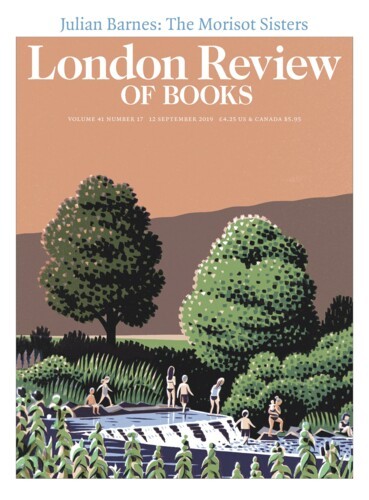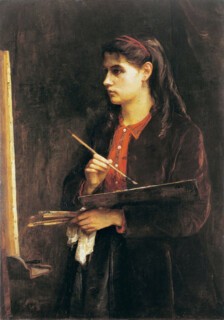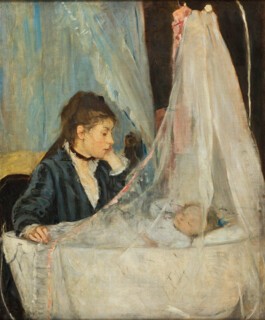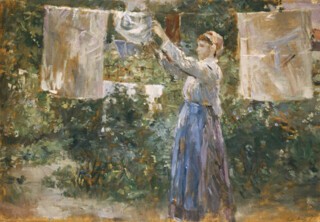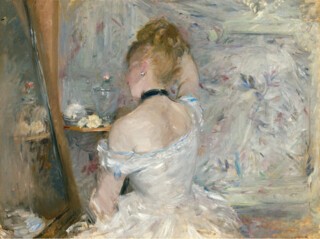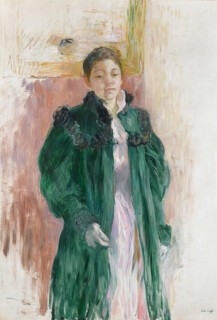Many artists live with a shadow version of themselves: an awareness of how things might have been if they had done this and not that, if life had made this choice for them rather than that. The road not taken remains at the back of the mind. For some their shadow is an external presence, for others an inner haunting. Few can have experienced it more precisely, with more emotional complexity, than Berthe Morisot.
To begin with, there were three sisters: Yves, Edma and Berthe, daughters of a senior civil servant, living in Passy, and signed up as a package by their mother for art lessons with a nearby hack painter, Père Chocarne. The motivation was not, of course, to turn them into artists, but rather to provide them with a charming amateur skill which would raise their vendability on the Parisian marriage market. This worked for Yves, who in 1866 was duly wedded to a one-armed veteran of the Mexican war, now turned tax-collector in Brittany. But Edma and Berthe were more persistent, and more talented; dissatisfied with Chocarne, they asked to be taught by a better master, and were sent to the Lyonnais painter (and pupil of Ingres) Joseph Guichard. From him they went to Corot, painting amid Corotian landscapes, and copying the master’s pictures. He then passed them on to his pupil François Oudinot. Clearly, this painting business was threatening to become more than just a social embellishment. Between 1861 and 1867 the two sisters travelled across France together, painting side by side en plein air, each acting as the other’s chaperone. Together, they submitted their work to the Salon. They were both very good – indeed, Edma was judged the better. Corot found her a more disciplined pupil, and exchanged pictures with her; Manet nearly bought one of her works.
But then comes the road taken, and not taken. In 1869 Edma, then 29, and still ‘infatuated’ with painting, married a naval officer, Adolphe Pontillon. Berthe carried on alone. For many years the two sisters had been such constant companions that they had never before written a letter to each other; now they began. Berthe’s first task was to console Edma: ‘This painting, this work that you mourn for, is the cause of many griefs and many sorrows … Come now, the lot you have chosen is not the worst one … Do not revile your fate. Remember that it is sad to be alone; despite anything that may be said or done, a woman has an immense need for affection.’ Berthe now required a new chaperone; her mother inherited the job. Berthe didn’t just need her when painting outdoors, she also needed her when being painted indoors. Manet was to make a dozen portraits of her, the most famous of which, Berthe Morisot with a Bouquet of Violets (1872), was, according to Paul Valéry, the best thing since Vermeer. They are his equivalent of Monet’s cathedral fronts, a set of pictures of the same scene but with different weather. They are also an intense exchange between subject and artist – some think Manet was in love with Morisot – and it is a slight shock to realise that, all through, Mme Morisot was riding shotgun. But Berthe’s reputation had to be protected, because she in turn would need to be married. Yet she continued to paint, and at the same age that Edma was married she took her own decision to make painting her life.
In 1865-68, Edma had painted a portrait of her sister: standing at the easel, brush in hand, in fiercely concentrating profile. It is a remarkably talented work, both as a character portrayal and as a construction. Berthe is wearing a plum-brown velvet coat over which her dark brown hair falls; underneath, there is a red blouse whose colour is picked up in her thin red headband. The tonality is generally dark, except for two fierce slashes of light. On the extreme left of the picture, the illuminated edge of Berthe’s canvas descends at a slight angle to the vertical. In the centre, a broader fall of light at the opposite angle illuminates a determined face, three white shirt buttons, the fingers of a painting hand and the whiteness of a dangling rag; it also falls, more discreetly, on the tip of her brush and the thin edge of her palette. The picture is rightly placed at the start of the Musée d’Orsay show, and has a double poignancy: internally, because it allows us to discern the strength of character which will make Berthe Morisot a true artist, even though she herself can’t. But also externally, because it is one of only two pictures by Edma to survive. At some point, and with what motivation we can only guess, she destroyed all her work except for this canvas and a landscape. The assertion of unfulfilled talent can often sound a little theoretical; but there is further evidence. In late 1873 Degas, who was helping to organise the First Impressionist Exhibition, wrote to Mme Morisot to seek her help in persuading Berthe to contribute: ‘We think Mlle Berthe Morisot’s name and talent are too important to us to do without,’ he writes. And then this supposed misogynist adds a further appeal to Edma, four years after her marriage: ‘I don’t know if Mme Pontillon is with you and if she would like to remember, as regards the exhibition, that she was a painter like her sister, and could be again.’ In the circumstances, it’s hard to imagine a more generous, and more tearingly sad phrase: ‘and could be again’.
The template for a potential artist’s career is often: enthusiastic family (especially mother) overpraises the slightest sketch, the haziest verse, the whisper of a tune; then the world – teacher, grown-up artist or writer or musician, and later the critical press – examines that talent with sterner eyes or ears, and stomps on it. With Berthe Morisot, this paradigm was reversed. It was her mother who doubted her talent, who urged her to quit, who wrote of her to Edma: ‘She has perhaps the necessary talent – I shall be delighted if such is the case – but she has not the kind of talent that has commercial value or wins public recognition; she will never sell anything done in her present manner, and she is incapable of painting differently.’ This wasn’t the objection of a philistine parent: Mme Morisot was a cultivated woman, on warm social terms with painters and composers (Rossini had picked out a piano for Berthe, and even signed it). She just wasn’t able to believe her daughter was good enough. Not even when assured of the fact by established artists: ‘Puvis [de Chavannes],’ she reports to Edma, ‘has told her that her work has such subtlety and distinction that it makes others miserable, and that he was returning home disgusted with himself. Frankly, is it as good as all that?’ Further: ‘M. Degas dropped in for a moment yesterday. He uttered some compliments, though he looked at nothing – he just had an impulse to be amiable for a change. To believe these great men, she has become an artist!’
Once she hit her stride, those artists she encountered – Monet, Pissarro, Degas, and even non-Impressionists like Puvis, Léon Bonnat, Sargent and Maurice Denis – recognised Morisot’s quality and treated her as an equal. Durand-Ruel, the pioneering dealer who (a century before Saatchi) batch-bought rising artists, took four of her pictures in 1872. Even the critics paid her the compliment of condemning her equally with her male associates. Reviewing the First Impressionist Exhibition in 1874, Alfred Wolff began his article in Le Figaro: ‘Five or six lunatics, one of whom is a woman,’ and ended it: ‘There is also a woman in the group, as is the case with all famous gangs. Her name is Berthe Morisot, and she is interesting to behold. In her, feminine grace is preserved amidst the frenzy of a mind in delirium.’ So she was just as talented, and just as mad, as the men. Her second teacher, Joseph Guichard, went along to the show, and concurred. Writing to Mme Morisot, he warned that ‘one does not associate with madmen except at one’s peril … All of these people are more or less touched in the head.’ The poor young woman was almost lost, but might yet be redeemed: ‘As painter, friend and physician, this is my prescription: she is to go to the Louvre twice a week, stand before Correggio for three hours, and beg his forgiveness.’
But Berthe Morisot did not beg; nor did she conform to stereotypes, even her own. In December 1874, a few years after committing herself to art, she married Eugène Manet, brother of Edouard. She was 33: ‘I went through that great ceremony without the least pomp, in a dress and a hat, like the old woman that I am, and without guests.’ Such downplaying is typical. Mallarmé, who subsequently became a great friend, wrote that his life was ‘without anecdote’, and Berthe seems determined to emulate him. She had her first and only child, Julie, at 37. She and Eugène also painted side by side; he did watercolours and pastels (and wrote a novel). But he was no artistic threat to her: it was he, rather than she, who complained that they didn’t get enough praise for their work. He was, in the words of Morisot’s biographer Anne Higonnet, ‘loyal but aimless’; he was also happy to assist with the practicality of exhibitions when she was too busy painting. Family life and motherhood did not overtake or interrupt her art. On the contrary: she claimed them as her subject matter.
For centuries, male artists had painted idealised Madonnas and Christ-children; yet even their most human depictions cannot escape the gilt halo – explicit or implicit – and the knowledge that this particular infant is a god made flesh. Now Morisot and Mary Cassatt painted secular mothers with earthly babies. Cassatt paints them more objectively: you feel the heft and weight and awkwardness of that infant flesh; Morisot, with the advantage, or prejudice, of being a mother herself, paints the emotional bond. Is there a finer, more tender portrayal of maternal love and absorption than The Cradle (1872)? Edma sits in profile beside her second daughter, left hand to cheek, right hand protectively across the cradle. Behind her is a pale mauvey-blue swathe of lacy curtain concealing the outside view; while the infant is half-concealed from us by a pale mauvey-blue swathe of lacy fabric covering the cradle and taking up half the picture. We can see enough to confirm that there is, indeed, a baby lying there; but the curtainings mean that our concentration can only be on the mother – enthralled, sweetly serious – whose concentration in turn can only be on the baby. The construction is as simple and strong as the mother’s love appears to be. A friend once told me that she had never wanted to have children, and faltered only when she saw this picture.
Flaubert wrote that ‘the story of a louse can be as beautiful as the history of Alexander the Great – everything depends on the execution.’ Artists had always known this, of course: Géricault did a painting called Twenty-Four Horses in Rear View (1813-14), three rows of eight (plus a twenty-fifth which has disobediently turned to face us), as if to say: ‘Look, horses’ arses can be as pictorially interesting as the face of a goddess – everything depends on the execution.’ But the Impressionists democratised subject matter as never before, terminally subverting the hierarchy of subject matter. And so Morisot paints the ordinary pursuits and pleasures of maternity: cradle-gazing, breastfeeding, hide-and-seek, butterfly-hunting, flower-gathering, dog-cuddling, picnicking, music lessons, sandcastle construction, boating … She paints fans and fabrics, women powdering and primping, and also women at work: sewing, clearing tables, hanging out the washing. Laundry – it’s white, and it moves! – was a popular subject for the Impressionists: Degas portrays the backbreaking female labour of the ironing-room; Manet (Laundry) shows a mother hand-wringing the wash while her child holds the clothes basket; Caillebotte has dramatic lines of billowing sheets and shirts; Morisot has a laundress pegging out the line in a back garden. Male labour – and men too – are elsewhere: in the whole of the d’Orsay show, only one man is pictured: Eugène Manet.
Here is female occupation, and preoccupation, and relaxation; all this, plus Morisot’s bright yet matt palette, might lead us to infer that these are scenes of pleasure and happiness – leisure time in the Belle Epoque. But maybe this is mistaken. Eugène is painted twice playing with their daughter, Julie; in each picture he is dull and dolorous of mien, unfascinatedly watching his daughter, a parent just playing at playing. Many of the girls and young women portrayed by Morisot seem wary and withdrawn, looking at us rather than communicating their essence. Infants are blithe, but adolescence brings complexity and trouble. Has ever a child pianist looked more bored – with the music she is playing, and with the viewer’s and artist’s interruption of it – than Lucie Léon at the Piano (1892)? One of Morisot’s more sinister paintings – not in the exhibition – is also of a single figure: Doll on the Veranda (1884) shows a table set for two, with a teapot and two cups; beyond the veranda is a rioting garden and nearby houses; but of the two chairs, one is empty, the other occupied by an abandoned doll. A single button-eye gazes out at us from its blank face. It is as if one of those anxious young women has been shrunk down to their essence.
The veranda, the balcony, the terrace: this partitioning off of indoor from outdoor space is a frequent Morisot trope. Her girls and women part curtains to gaze from a balcony at the world beyond; sit reading in a winter garden; play with a cup at a veranda window. Outdoors, a woman sits on a terrace with holidaymakers and boats in the distance behind her; from behind a fence, two women and a child sagely survey Paris from the heights of the Trocadéro. Is it about what is sage, and safe – the known domestic spaces versus the unknown, anxious-making ones? Except that the public gardens and curated fields of Morisot’s outdoors look more suburban than threatening. Is it glancingly – or even centrally – about female containment, the limits placed on women’s movement, and beyond that on female behaviour, even thought? Sometimes, perhaps: but here is Eugène Manet on the Isle of Wight, looking dolefully out through two barriers, the sitting-room window of their lodgings, and a line of street railings beyond. Is he being contained too? (Well, he was on his honeymoon.) Sometimes a formal device is just a formal device. As it had been, for instance, when Morisot posed for Manet, leaning on the green iron bars of The Balcony (1868-69).
By the time of the Third Impressionist Exhibition in 1877 (organised by Caillebotte, and including Cézanne), one critic, Paul Mantz, declared in Le Temps: ‘The truth is that there’s only one Impressionist in the … group: and that is Berthe Morisot.’ She can even be seen as the ur-Impressionist, who wrote in her notebook: ‘For a long time I have hoped for nothing; while the desire for posthumous glory seems to me an exorbitant ambition. Mine would limit itself to wanting to capture something of what disappears before our eyes. Oh, that “something”! The least of things. Well, even that ambition strikes me as exorbitant.’
She began with a suave precision akin to that of early Renoir; then gradually, over her career, her brushwork gets broader and looser, and backgrounds become approximations. In perhaps her most famous painting, Woman at Her Toilette (1875-80), a young woman is fixing her hair at a mirror; the flesh of her neck and nape and bare left shoulder are in clear focus for our prying eye; her white dress with blue trim feeds off into a haze of pinky-bluey-white background which might be a curtain or perhaps a screen, while the mirror reflects confusingly back. It is as if the world around her – the world which awaits her after completing her toilette – is a beautiful blur, and only her flesh is solid. In The Fable of 1883, a mother on a bench and child on a folding stool learn a lesson; in front of them are a series of whitish patches which resolve themselves eventually into a panicked run of chickens – not so much chickens as a true whirling impression of chickens. In Self-Portrait of 1885 her brush and palette – despite being things of the utmost centrality to her life – are reduced to a few cursory brown lines and a tomato-red squiggle. By the end of this development – in Young Girl with a Greyhound (1893), Young Girl in a Green Coat (1894), and two studies of Julie playing the violin – there is an elongated sketchiness reminiscent of Munch portraits. Except that this is the wrong way round, given the chronology. It is Munch portraits that ought to remind us of Morisot. She is never other than herself. Do the white streaks and strokes with which she often overpaints early scenes remind us of Manet? Mainly because ‘Manet white’ was one of her brother-in-law’s breakthroughs. The pictures themselves don’t look like Manets.
One of the main reasons the Impressionists’ new ways of painting caused offence was that they looked – to the untrained eye, and even to some trained eyes – slapdash. In 1885 Morisot records Léon Bonnat’s frustration at Manet’s getting away with ‘not modelling the cheeks or the foreheads of his subjects’. There was a suspicion that what they didn’t do, they couldn’t do. And yet, the artists themselves knew very well what escaped them, and it usually wasn’t what the public imagined. Manet, for instance, admitted that when painting The Races in the Bois de Boulogne (1872), he was inexperienced at doing horses. ‘And so,’ he told Morisot, ‘I copied painters who knew how to render them better than me – and now everyone’s criticising my horses.’ But (perhaps because of their nickname, given by a critic not a friend) many suspected that the Impressionists merely dashed or splashed down an impression of whatever was in front of them, that vigour and instinct were all. In January 1886 Morisot visited Renoir, and noticed a drawing in chalk and red crayon of a young woman breastfeeding a child:
While I was admiring it, he showed me a whole series of drawings of the same model in more or less the same pose; he is a draughtsman of the highest calibre. It would be interesting to present all these preparatory studies to a public which in general imagines that the Impressionists work with the greatest casualness.
The first entry in her notebooks (five of which are reproduced at the back of the d’Orsay catalogue) is from May 1885:
On Thursday, Degas was saying how the study of nature is unimportant, that painting was an art of convention, and that it was infinitely better to learn how to draw from Holbein; that even Edouard [Manet], although he boasted about slavishly copying nature, was the most mannered painter in the world, never applying a drop of paint without thinking of the great masters, and, for example, not putting fingernails on his subjects’ hands because Frans Hals didn’t draw them in.
The painters Morisot looked back to were Rubens and Boucher, Perronneau, Reynolds, Romney and ‘early’ Ingres. ‘It seems to me that Rubens is perhaps the only painter who has completely rendered beauty: the humid glance, the shadows of the eyelashes, the transparent skin, the silky hair, the gracefulness of posture.’ In Haarlem she was ‘disappointed’ by Frans Hals; in Amsterdam, Rembrandt’s The Night Watch ‘seemed to me of the most disagreeable blackish brown’.
This is a typical judgment. She does not give easy praise. That stern concentration and barely withheld fierceness delineated in Edma’s portrait of the youthful Berthe are given full expression in her notebooks. Like many, I’ve always viewed the arc of French painting in the century from about 1820 to 1920 as a battle between colour and line. Colour exemplified by Delacroix, line exemplified by Ingres, then victory for colour with the Impressionists, followed by victory for line with the Cubists, then a reintegration when the Cubists allowed colour back in. It is chastening as well as useful to be rebuked by Morisot for such facile broad-brushery:
All painting is a copy from nature, of course, but is it the same when copied by Boucher as when copied by Holbein? Yet they are each as true as one another, whether this truth is expressed by line or by colour. This perpetual distinction between line and colour is puerile, for the simple reason that colour is nothing more or less than an expression of form.
In an entry from 1893, she writes: ‘Modern novels and modern painters bore me; I love only extreme novelty or the things of yesteryear. Only one current exhibition amuses me: the Independents [where she had shown alongside Seurat and Signac], and I adore the Louvre.’
Like Mary Cassatt, she was a painter who knew her own value, and who maintained it, despite the world being tipped and freighted against her sex. In the early 1870s she was reading Darwin: ‘It is scarcely reading for a woman, still less for a young girl. What I see most clearly is that my situation is impossible from every point of view.’ Twenty years later, in what she considered old age, she concluded, ‘I don’t think there has ever been a man who treated a woman as an equal, and that’s all I would have asked, for I know I am worth as much as they.’ The poet Henri de Régnier wrote of her ‘taciturn melancholy and fierce shyness’; also, her ‘lofty timidity’. When Monet – who had the most ‘commercial value’ and ‘public recognition’ of all the Impressionists – wrote to her in 1888 that he would be ‘eager to know’ her opinion of his latest show at Goupil’s gallery, her reply was brisk: ‘You have indeed conquered it, that recalcitrant public of ours. At Goupil’s one only meets with utterly admiring people, and I think there is quite a bit of coquettishness in your query about the impression produced; it’s a dazzling sight, and you know it very well.’
In 1890, when Manet’s Olympia was accepted by the French state after fundraising by the chief Impressionists, Morisot concluded that ‘we’ve come a long way from the stupid jokes of yesterday.’ And it had taken only twenty years for the first-generation Impressionists themselves to become classics, and to be collected as such: in 1894, the year before her death, the French state bought its first Morisot, Woman at a Ball (1879). But in some ways, Mme Morisot had not been wrong: despite the praise of peers and of critics, Berthe did not have a great deal of ‘commercial value’ or ‘public recognition’ (though her guarded nature would not have welcomed the latter). She showed at seven of the eight Impressionist Exhibitions, and Durand-Ruel offered her work in Boston, New York and London. She created about 860 paintings. Yet it seems she only sold between 25 and 40 of them – Zola, Alfred Stevens, Monet and Chausson were among the purchasers – and gave away around 25 more. By the time of her death, three-quarters of her output remained with her family. And when the French state came to describe her on her death certificate, it wrote: ‘no profession’.
In a notebook for 1891, Berthe Morisot wrote: ‘I say that “I want to die,” but that isn’t true at all. I want to grow young again.’ Four years later, she was travelling with her daughter in the South of France. Julie caught a grippe, and Berthe was concerned that it might be the start of typhoid fever. Then Berthe caught it, and developed pneumonia. Her sister and shadow artist Edma rushed to her side, bringing with her the two daughters she had had instead of a career. On 1 March, the day before her death, Berthe wrote Julie the fullest and most touching farewell, both as a mother and as an artist:
My little Julie, I love you as I die; I shall still love you even when I am dead; I beg you not to cry, this parting was inevitable. I hoped to live until you were married … Work and be good as you have always been; you have not caused me one sorrow in your little life. You have beauty, money; make good use of them … Please give a remembrance to your Aunt Edma and to your cousins … Tell M. Degas that if he founds a museum he should select a Manet. A souvenir to Monet, to Renoir, and one of my drawings to [the sculptor Paul-Albert] Bartholomé. Give something to the two concierges. Do not cry.
Edma, recently widowed, took up art again after a quarter of a century. And what did she produce? Copies in pastel of pictures by Berthe. They were as admirably precise as the copies she had done of Corot, decades before.
Send Letters To:
The Editor
London Review of Books,
28 Little Russell Street
London, WC1A 2HN
letters@lrb.co.uk
Please include name, address, and a telephone number.
